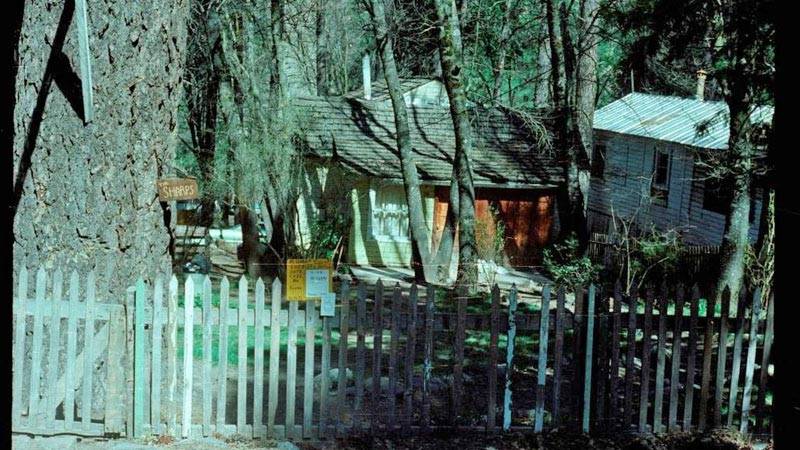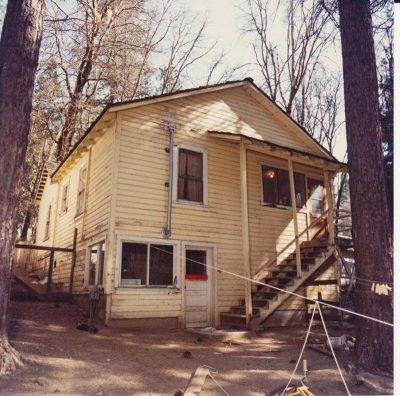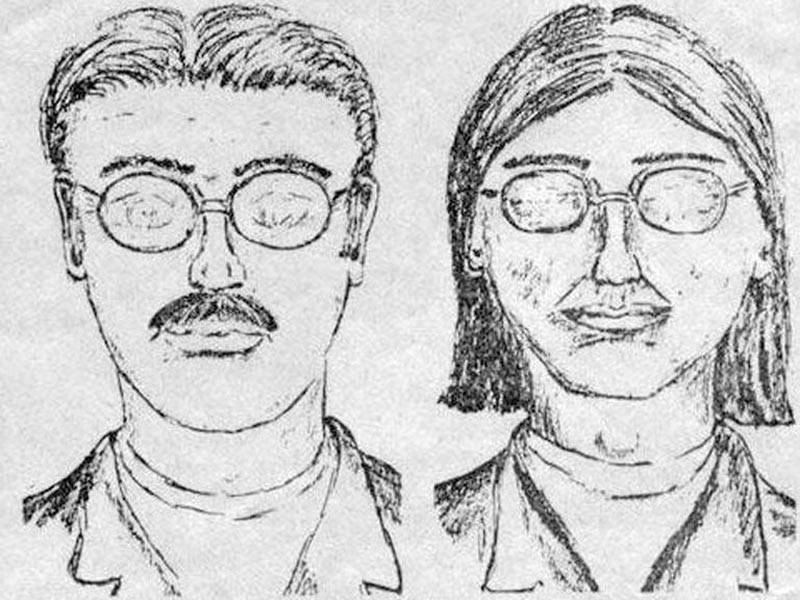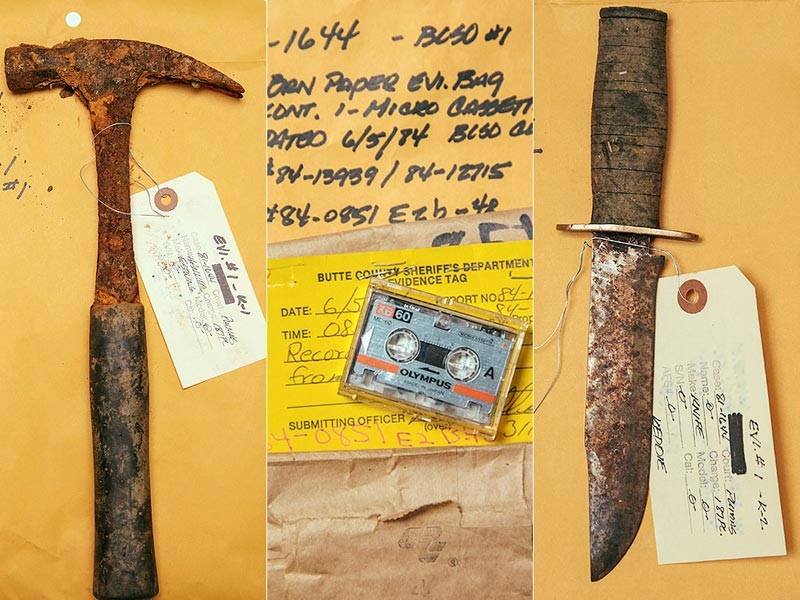Between April 11 and April 12, 1981, Glenna "Sue" Sharp and three others were brutally killed in the resort town of Keddie, California. To this day, the murders remain unsolved.

Plumas County Sheriff’s Office Cabin 28 at Keddie Resort, 1981. The former Sharp home was condemned and demolished in 2004
On the morning of April 12, 1981, Sheila Sharp returned to her home at Cabin 28 in the Keddie Resorts in California from the next-door neighbor’s house. What the 14-year-old girl discovered inside the modest four-room cabin instantly became one of the most macabre scenes in modern American crime history — and has come to be known as the gruesome Keddie murders.
Inside Cabin 28 were the bodies of her mother, Glenna “Sue” Sharp, her teenage brother John, and his high school friend, Dana Wingate. The three had been bound by medical and electrical tape and had either been viciously stabbed, strangled, or bludgeoned. Sheila’s sister, 12-year-old Tina Sharp, was nowhere to be found.
Stranger still, in an adjoining bedroom the two youngest Sharp boys, Rickey and Greg, as well as their friend and neighbor, 12-year-old Justin Smartt were found unharmed. They had apparently slept through the entire massacre which had unfolded mere feet from their beds.
The Keddie Cabin Murders

Plumas County Sheriff’s DepartmentA back view of cabin 28 where the family had lived for a year.
The Sharp family had just moved in to cabin 28 the year before. Sue had just divorced her husband and brought her children from Connecticut to Keddie in Northern California. The six of them: 36-year-old Sue, her 15-year-old son John, 14-year-old daughter Sheila, 12-year-old daughter Tina, and 10-year-old Rick and 5-year-old Greg, were friendly with their nearby neighbors at the Keddie resort.
The night before the murders, Sheila had slept over a friend’s house down the street. John and his 17-year-old friend Dana had hitchhiked to a nearby town of Quincy for a party and returned sometime later that evening. Tina had briefly joined her sister at the neighbors before returning home to her mother, two younger brothers, and one of the neighbor boys, Justin Smartt.
When Sheila returned home early the next morning to find her mother, brother, and his friend bloodied on the living room floor, she bolted back to her neighbor’s house. Her friend’s dad retrieved the three unharmed boys through their bedroom window so they would not have to see the scene.
The murders had been notably violent. Investigators were called about an hour after Sheila had discovered her slain family. Deputy Hank Klement was the first to arrive on the scene and he reported blood everywhere — on the walls, the bottoms of the victim’s shoes, Sue’s bare feet, the bedding in Tina’s room, the furniture, the ceiling, the doors, and on the back steps.
The prevalence of blood suggested to investigators that the victims had been moved and rearranged from the positions in which they were murdered.

Plumas County Sheriff’s Department The Keddie family about four years before the murders.
Young John was closest to the front door, face-up, his hands blood-covered and bound with medical tape. His throat had been slit. His friend Dana was on the floor beside him on his stomach. His head was badly damaged as though bashed in with a blunt object and lay partially on a pillow. He had been manually strangled. His ankles were tied with electrical wire which was wound also around John’s ankles so that the two were connected.
Sheila’s mother had been covered partially with a blanket though that had done little to hide her gruesome injuries. On her side, the mother of five was naked from the waist down, tightly gagged with a bandana and her own underwear secured with medical tape. She had injuries consistent with a struggle and had an imprint of the butt of an .880 pellet gun on the side of her head. Like her son, her throat had been cut.
All victims had suffered blunt-force trauma by hammer or hammers. They also all sustained multiple stab wounds. A bent steak knife was on the floor. A butcher knife and claw hammer, both also bloodied, were side-by-side on a small wooden table near the entry into the kitchen.
It would take the police hours to realize that a fourth victim, Tina, was missing.
The Botched Investigation Into The Cabin 28 Murders
When it was eventually discovered that Tina Sharp was missing, the FBI arrived on the scene.
The sheriff at the time of the murders, Doug Thomas, and his deputy. Lt. Don Stoy, were not initially able to discern an apparent motive. The murders at Keddie Cabin 28 appeared to be random acts of cruelty. “The strangest thing is that there is no apparent motive. Any case without an apparent motive is the toughest to solve,” Stoy recalled to the Sacramento Bee in 1987.
Further, the home did not indicate forced entry, though detectives did recover an unidentified fingerprint from a handrail on the back stairs. The cabin’s telephone had been left off the hook and all of the lights had been shut off as well as the drapes closed.
More confounding is that the three youngest boys were not only untouched but allegedly unaware of the event, even though a woman and her boyfriend in the cabin next door awoke around 1:30 a.m. to what they described were muffled screams. Unable to discern from where they were coming, they went back to bed.
However, though the three boys initially claimed to have slept through the massacre, Rickey and Greg’s friend Justin Smartt did later say that he saw Sue with two men in the house that night. One reportedly had a mustache and long hair and the other was clean-shaven with short hair but both in glasses. One of the men had a hammer.

Plumas County Sheriff’s OfficeComposite sketch of the Keddie murder suspects.
Justin reported then that John and Dana entered the home and argued with the men which resulted in a violent fight. Tina was then allegedly taken out the cabin’s back door by one of the men.
Allegedly, a lot of potential evidence was collected at the scene but because this was pre-DNA testing, very little helpful information was found at this time.
Sheriff Thomas called the Sacramento Department of Justice which then sent in two special agents from their organized crime unit — not homicide, which struck many as odd.
Immediately, the two lead suspects were Justin Smartt’s father and the Sharp’s neighbors, Martin Smartt and his houseguest, ex-convict John “Bo” Boudebe who was known to have connections to organized crime in the area. Both men had been seen in suits and ties behaving oddly in the bar the night before.
Martin Smartt later told the police that he had a hammer that matched the one discovered and also that his hammer and gone “missing” shortly before the murders. Later that year, a knife was recovered in a trashcan outside the Keddie General Store; authorities also believed this item to be linked to the crimes.
It would be another three years after the Keddie murders that Tina was found.
A man discovered a human skull in the adjoining Butte County, about 30 miles from Keddie, in Plumas County. Near the remains detectives also found a child’s blanket, a blue nylon jacket, a pair of jeans with a missing back pocket, and an empty surgical tape dispenser.
With that, the remains of Tina Sharp had been found, which made the crimes committed on April 11 or 12, 1981, a quadruple homicide.
The Butte County Sheriff’s Department soon received an anonymous call asking, “I was wondering if they thought of the murder up in Keddie up in Plumas County a couple years ago where a 12-year-old girl was never found?”
Meanwhile, Sheriff Thomas had resigned from the investigation three months in and taken a job instead at the Sacramento Department of Justice. His handling of the case in retrospect would be considered disastrous at best and corrupt at worst. “I was told the suspects were told to get out of town, so to me, that means it was covered up,” Sheila Sharp told CBS Sacramento in 2016.
The Sharps’ home was demolished in 2004.
Evidence At Cabin 28 Ignored And Overlooked
Remarkably, the tape of the anonymous tip regarding Tina was found sealed in case files, untouched by Plumas County Sheriff’s Dept. until 2013 when the case was reopened with new investigators Plumas Sheriff Greg Hagwood and Special Investigator Mike Gamberg.
In 2016, Gamberg located a hammer believed to be one of the murder weapons in a dried-up pond in Keddie.
Further, it came to light that Marilyn Smartt, Marty’s wife and mother of Justin, had left her husband on the day of the murder discovery. Afterward, she provided Plumas Country Sheriff’s Dept. with a handwritten letter sent to her and signed by her estranged husband. It read: “I’ve paid the price of your love & now that I’ve bought it with four people’s lives, you tell me we are through. Great! What else do you want?”
This letter was not treated as a confession nor was it followed up on at the time. Even though Marilyn admitted in a 2008 documentary that she thought her husband and his friend Bo was responsible, Sheriff Doug Thomas contradicted this and stated that Martin had successfully passed a polygraph test. It was later confirmed that Martin was close with this Sheriff.
In 2016, Mike Gamberg met with a counselor at the Reno Veterans Administration.
The anonymous counselor told him that in May 1981, Martin Smartt had confessed to killing Sue and Tina Sharp. “I killed the woman and her daughter, but I didn’t have anything to do with the [boys],” he purportedly told the counselor. When the DOJ was alerted to this confession in 1981, they dismissed it as “hearsay.”
The Keddie Murders Revisited

Plumas County Sheriff’s OfficeProbable murder weapons for the Keddie slaying discovered and submitted as evidence in 2016. Between them lies the forgotten tape of the anonymous phone tip left in 1984, rediscovered in 2013.
The most widely accepted theory involves a love triangle between Martin, Marilyn, and Sue.
It was believed that Martin and Sue were having an affair and that Sue was supposedly counseling Marilyn to leave her husband, who she had said was abusive to her. When Martin discovered this, he enlisted Bo, his friend, and known mob enforcer who had lived with the Smartt’s a mere 10 days before the Keddie murders, to take Sue out of the picture.
This would account for Marilyn leaving her husband the day of the murder discovery. It would also explain why the Smartt boy and the other Sharp boys in the adjoining room were spared. Additionally, it gives context to Martin’s handwritten note that Marilyn gave to the Plumas Sheriff’s Dept.
Some investigators who picked up the case when it reopened in 2013 tie the slayings into an even larger plot. To Gamberg, it is clear that the DOJ and Thomas-run Sherriff’s Dept. “covered it up, is the way it sounds.” He alleges that Bo and Martin fit into a larger drug-smuggling scheme that involved the federal government.
Martin was a known drug dealer and Bo was connected to Chicago crime syndicates with financial interests in drug distribution.
This might explain why the Sacramento DOJ sent two allegedly corrupt organized crime special agents instead of agents from the homicide department. It also provides an explanation as to why the two lead suspects were seemingly given a free pass and told to leave town by Sheriff Thomas.
Furthermore, it suggests an answer as to why this case was handled so sloppily, remains unsolved, and is seemingly not a priority to the Sacramento DOJ.
What is known is that this 37-year-old crime is far from a cold case, as new evidence sheds light on what may have occurred at Cabin 28 in Keddie, California.
Although both Martin Smartt and Bo Boudebe are now deceased, new DNA evidence has pointed investigators to other suspects who may have had a hand in these murders, and who are still alive.
“It’s my belief that there were more than two people who were involved in the totality of the crime–the disposal of the evidence and the abduction of the little girl,” Hagwood said. “We’re convinced that there are a handful of people that fit those roles who are still alive.”
After learning about the Keddie cabin murders, read about another unsolved murder, the Lake Bodom homicides that continue to confound authorities. Then, see if you can solve any of these six inexplicable, unsolved murders.





